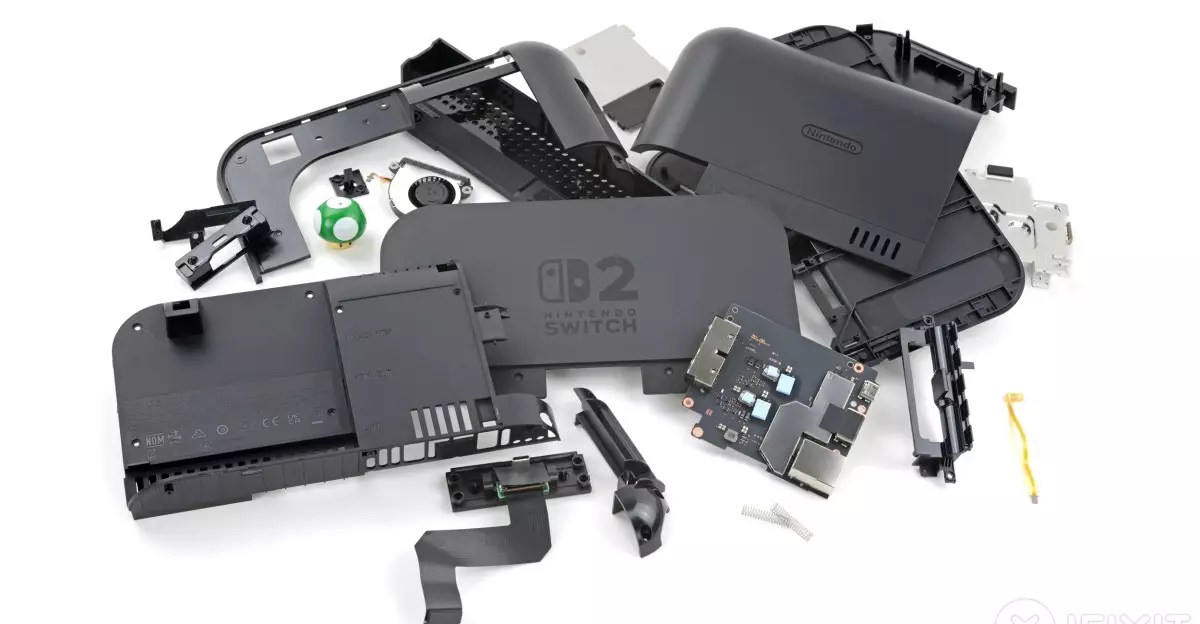In the evolving landscape of gaming technology, repairability has become a pressing concern for consumers and gamers alike. Nintendo, a brand that once stood as a paragon of accessibility in electronics, seems to be stepping ominously backward with its latest offering: the Switch 2. A recent teardown from iFixit, renowned for its in-depth device reparability analysis, has delivered startling findings that should raise alarms for prospective buyers. The Switch 2 has been assigned a meager repairability score of 3 out of 10—the lowest in the series—pointing to a paradigm where convenience and user-friendliness are seemingly sacrificed on the altar of streamlined manufacturing.
The original Nintendo Switch had garnered praise for its innovative design, but the recent downgrade in repairability scores, including an astonishing drop from 8 to 4 for the initial model, reflects a stark shift in the company’s priorities. It seems that the need for a quick and efficient manufacturing process has taken precedence over consumer needs and sustainability. This raises troubling questions about where the company is heading, especially when considering the future of consumer electronics should ideally be one where repairing and recycling are accessible.
Sticky Situations: The Battery and Beyond
One of the most glaring issues highlighted in the iFixit teardown is the Switch 2’s battery situation, which remains far from user-friendly. The battery is “glued in with powerful adhesive,” making replacement not just a challenge, but a daunting task that leaves many would-be repairers grappling with tools and a mess of disintegrated foam padding. The reliance on such adhesive invokes significant frustration, particularly when simpler methods of securing a battery could mitigate long-term waste. The fact that previous models offered more straightforward methods for battery replacement has rendered the Switch 2’s design feel like a step backward, making one wonder how customer-centric Nintendo really is.
Furthermore, components like the flash storage modules and USB-C ports are soldered directly to the main board, thus compounding the issue of replaceability. Unlike previous models, this means that even minor failures can lead to significant repairs, pushing financial burdens onto consumers who may not have the means to replace whole systems. This design choice not only alienates DIY enthusiasts but also compromises the longevity of the device itself.
A Paradigm of Obsolescence
It’s no secret that game consoles are not immune to wear and tear; the infamous joystick drift of the original Switch has surfaced as a cautionary tale that remains fresh in players’ minds. While Nintendo has equipped the new Joy-Cons with the same—if not worse—potential for future degradation, it’s concerning that the repair procedures have become convoluted. The increased difficulty in accessing these joysticks and other internals seems to suggest a worrying trend: a deliberate move towards planned obsolescence. Instead of innovating more durable, user-repairable designs, Nintendo appears to be pushing users toward external service options, which may not only cost more but could eventually lead to e-waste rivals of epic proportions.
Even popular gaming accessories, once accessible, are now being treated with a similar approach—the tear-down suggests the games card reader is also soldered down. For gamers who rely on physical media, this is a nightmare scenario. The legacy of having easily replaceable parts is all but vanishing, and the gaming community should take a firm stance on demanding better from a company that has charm and nostalgia tied around its reputation.
What’s Next for Nintendo?
The implications of these revelations go beyond mere inconvenience; they reflect a growing trend in tech industries where repairability takes a back seat to sleek design and production efficiency. Consumers deserve transparency, reliability, and most importantly, the power to fix what they own. As we navigate through a world increasingly bogged down by planned obsolescence, it’s time for gamers to demand change. The Nintendo Switch 2, while certainly packed with innovation and potential, risks becoming an emblem of consumer frustration rather than a standout in modern gaming. As gaming continues to evolve, the real question should be: How soon will companies realize that the future of technology lies not just in new releases but also in making those releases sustainable and repairable?


Leave a Reply